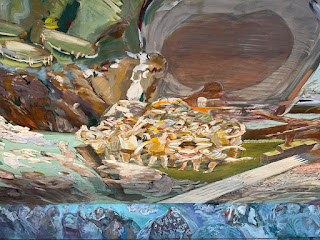Richardson Auditorium at Princeton University. Orchestra (Free).
Great musicians, lovely program. A couple of questions. How does one keep a 300-year old cello that shiny? And is the dress made from plastic?
Artists
Jesse Mills, violin; Ole Akahoshi, cello; Rieko Aizawa piano.
Program
Trio (1937) by Leonard Bernstein (1918-1990).
Phantasiestucke Project
- Remembrance (2022) by Derek Bermel (b. 1967).
- Eldorado (2022) by David Fulmer (b. 1981).
- Fantasy "Little Dragonfly" (2020) by Paul Chihara (b. 1938).
Trio No. 2 in E-flat major, D.929 (1827) by Franz Schubert (1797-1828).
This was the first of four Princeton University Summer Chamber Concerts. Richardson Auditorium will be closed later in the summer for repairs, so this would be the only concert held at that place. Subsequent ones will be in the Presbyterian Church on Nassau Street.
It was a delightful program. A bit on the long side. We started a little after 7:30 pm, and didn't end until 9:30 pm. There was a 20-or-so minute intermission, and Jesse Mills talked a little about the first pieces in the program.
Leonard Bernstein wrote the Trio when he was 18 or 19, while a student at Harvard. The musicologist probably can hear the beginnings of the musical idioms that would set him apart. To me it was "wow, I didn't know he could wrote this as a teenager." The three movements are (1) Adagio non troppo - Piu mosso - Allegro vivace; (2) Tempo di marcia; and (3) Largo - Allegro vivo et molto ritmico. Equally impressive was how well the three musicians work together. Part of the joy of listening to chamber music is to appreciate the give-and-take, and the three blended very well.
The "Fantasies Pieces" project (no idea why they needed German names) was a collection of three short pieces by living composers, written in tribute to Schuman. The "Remembrance" piece started with a simple tune of Schumann, and went from there. Eldorado was more abstract. "Little Dragonfly" has an interesting story behind it. Chihara is second generation Japanese American, and was sent to internment camp in Ohio during the war. When he went back to Japan he heard this tune "Red Dragonfly" which was appropriated from a tune by Schumann. So the tune in a way came full circle when it got incorporated into this piece.
It was surprising that I found all three pieces quite accessible. There may be modern writing, but the romantic (or classical) roots were the anchor throughout. It is somewhat unfortunate that the compelling story behind the Chihara piece isn't quite reflected in the music. Given the story behind it, I expected it would elicit more emotion from me, but the tune quickly faded into the "fantasy" part of the composition; even though it came back a couple of times, the magic was already lost.
When someone looks at a modern painting, he won't simply scan it once and walk away. Even better if there is a docent pointing out different aspects of the painting that hold special significance (either to the painter or the critic). With most modern music, the listener gets to hear it once, probably not enough for him to grasp the "story," especially if he hears the composer for the first time.
The Schubert trio exhibits all the characteristics I come to expect of Schubert's chamber music. The good aspects are all there: tunes, balance, harmony, structure, drama. One not-so-appreciated characteristic, alas, is the amount of repetition and the resulting length. I suppose the listener's mindset has a lot to do with it - see my comments on his "Great" symphony. Perhaps this was my first encounter, or perhaps the repetitions were not that many, it didn't feel as long as a 45-miunte piece could be. The movements are Allegro; Andante con moto; Scherzando: Allegro moderato; and Allegro moderato.
The pianist Aizawa got a real work out in the Schubert piece (not to say the other pieces were easy). In general the piano sounded louder than the other two instruments. Akahoshi produced a great sound with the Matteo Goffriller cello (c. 1707), but sounded weaker than the other two. I wonder how much they rehearsed in the auditorium. The placement of the two string players also crowded out our view of the pianist, thus I couldn't get to see how she tackled the instrument.
All in all a great concert. I mentally noted down quite a few things while listening to the music, but have forgotten most of the specifics a day later. That's too bad.
Horszowski was a well-known piano teacher at Curtis, and Aizawa was a student of his. They have performed at Princeton several times before. This was our first encounter.
This weekend was supposed to be rainy, but we managed to dodge the rain drops, which didn't turn out to be too bad anyway.













































